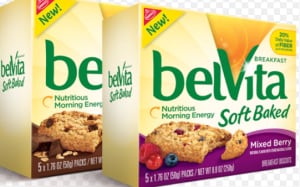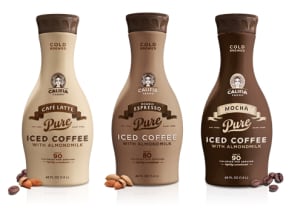Now this kind of failure rate may not surprise many struggling entrepreneurs; but they should draw some consolation from the fact that CPG giants are no better at developing winners, despite their deep pockets.
Indeed, even major CPG product launches identified as ‘pacesetters’ by IRI because they do well in their first year on the shelf often fail to live up to their early promise, with sales fizzling out after two or three years, says IRI editor of thought leadership, Susan Viamari.
“We did an analysis last year that looked at 258 pacesetters from 2002 to 2011. Only 44% still existed in January 2013… and only seven of 2013’s pacesetters generated more than $100m in sales during their first year”.
Launching big is not the definitive way to sustainable growth
Indeed, as James Richardson, senior vice president at Hartman Strategy notes in a recent report on new product development (click HERE), while CPG's big guns are great at fast-build distribution, they have got a pretty lousy track record of building “long term sustainable growth engines”.
The real success stories, by contrast, tap into new consumer trends and nearly always start small, building momentum gradually, he says.
”If you can generate $100m in sales in year one, you’re probably meeting the needs of existing consumers or a niche of heavy users, not tomorrow’s consumers. Launching big is not the definitive way to sustainable growth.”
Meanwhile, for many large companies that need to retain shelf space, “most innovations are more about trade management than about creating completely new consumer needs”, he observes.
Nielsen: One could dismiss belVita as ‘just a cookie’, but consumers found extraordinary relevance in this product
So what does successful innovation look like?
It can vary, says Taddy Hall, senior vice president, innovation, at Nielsen. But one thing is clear: “How 'different' a product looks turns out to be a very poor predictor of success.”

For example, says Hall in a recent report on 'breakthrough innovation': “One could dismiss belVita as ‘just a cookie [yet year one sales topped $70M and year two growth topped 50% percent growth], International Delight Iced Coffee as ‘just flavored coffee in half-gallon jug’, Barcel Takis as ‘just another salty snack’ and Nature Valley Protein Bars [which generated almost $100m in year one and 25%+ growth in year two] as simply a ‘granola bar with more nuts’ and on and on…
“In fact, one could dismiss the majority of our breakthrough winners with aloof dispatch. But consumer behavior suggests a decidedly different assessment.
"Of the 3,463 products launched in 2012, only 71 sold more than $50m. In short, consumers found extraordinary relevance in these products.”
Critically, ‘breakthrough winners’ identified by Nielsen all added incremental growth to a category by attracting new buyers or creating new consumption opportunities, he added.
You’re building a business, not just a brand…
When it comes to what distinguishes winners from losers among F&B start-ups, meanwhile, one entrepreneur-turned advisor and investor who has a better handle on this than most is Brad Barnhorn, founder of the Fantasia Fresh Juice Company - which was sold to North Castle Partners in 2000 and later merged with Naked Juice (which was acquired by Pepsi).
Today, Barnhorn advises several private equity funds investing in consumer products, but also serves on the board of several small but rapidly-growing food & beverage firms from KeVita (sparkling probiotic drinks), to KRAVE Jerky (gourmet jerky), Rhythm SuperFoods (kale chips), IPS Naturals (egg white chips), Zola (acai & coconut water), and Health Warrior (chia bars).
Innovation is not just about a brand or a product, but about a business model
While Barnhorn is wary of issuing ‘five things all successful entrepreneurs have in common’ type platitudes, people that really understand that they are building a business, not just a brand, generally do better, he says.
“Innovation is not just about a brand or a product, which can be imitated, but about a business model, how you manage your supply chain, things that can’t be replicated so easily.”
Things will change and things will go wrong
As for the skillset, passion is vital, but entrepreneurs must also be pragmatic, and capable of adapting to new circumstances, he says.

“I look for someone that can think through multiple potential paths versus a one-trick-pony that thinks only one model works, and as soon as things don’t align with that, can’t adjust. You need someone that can allocate 50% of his brain to alternative scenarios, because things will change and things will go wrong.”
Entrepreneurs also need to be prepared to move rapidly, as in a fast-paced environment such as food and beverage, you may only have a six-month window of opportunity to make your mark, he says.
“10 years ago, you might start in Whole Foods, build up over 3-4 years, get your business model figured out and then move to the mainstream channel over another 3-4 years.”
Today, he says, buyers at Target and other big chains are going to the trade shows and looking at young brands at a much earlier stage, and if they show interest, you need to be ready, or you could miss an opportunity.
Just because you’re a success in New York doesn’t mean you’ll be a hit in Chicago
When Barnhorn looks at an early stage company he looks at velocity (is the brand generating rapid repeat sales?), the management team, whether the firm is tapping into hot consumer trends (such as plant-based foods, vegetable based snacking, probiotics etc), but also at how scalable the brand and business model might be.
Just because a product does really well in one region doesn’t necessarily mean it will do well in in another, he points out.
“Take granola. There are so many artisan granola brands that just because you’re the local brand in New York doesn’t mean you can replicate this success in Chicago.”
Disruptive innovation?
As for ‘disruptive innovation’, this over-used phrase needs picking apart, adds Barnhorn. Crucially, you don’t have to be disruptive in every aspect of your business to succeed, he stresses. In fact too much disruption can create unnecessary risk and lead to inertia.

“Look at Califia Farms [run by ex-Odwalla founder Greg Steltenpohl]. They have beautiful innovative packaging, but they are not introducing completely new functional ingredients; they are putting together new combinations of ingredients that people already know such as cold-brew coffee and almond milk for example, so there is no barrier to trial and they don’t have to spend as much time on consumer education.”
As for financing, there are great tools such as CircleUp that early stage entrepreneurs can use now to raise initial capital once friends, family and bank loans are exhausted, he says.
But when it comes to the second wave of financing, he says, firms sometimes need to accept that it’s better to have “30% of a $20m company than 80% of zero”.
Click on the links below to find out what Greg Steltenpohl and other CEOs had to say about disruptive innovation, and financing an early stage F&B business at our recent Beverage Entrepreneurs Forum:
